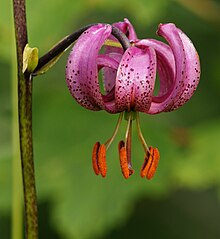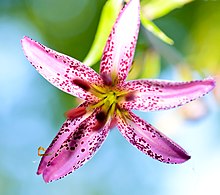Turk Association
| Turk Association | ||||||||||||
|---|---|---|---|---|---|---|---|---|---|---|---|---|

Turk's Union ( Lilium martagon ) |
||||||||||||
| Systematics | ||||||||||||
|
||||||||||||
| Scientific name | ||||||||||||
| Lilium martagon | ||||||||||||
| L. |
The Türkenbund ( Lilium martagon ), or martagon is a vegetable art from the genus of lilies ( Lilium ) in the same named Martagon section . Due to its strikingly shaped flowers and great height, it is one of the most stately lilies native to Europe.
description
The Turk's Union is a perennial , herbaceous plant that reaches heights of between 30 and 150 centimeters, rarely up to 200 centimeters. The oval onion can reach a diameter of eight centimeters and consists of many yellow, waisted scales. Like many geophytes, it is characterized by traction roots , which ensure that the onion remains at sufficient depth.
The simple, strong stem is round and usually red-spotted. The stem is especially leafy below. In the middle of the stem, the leaves are arranged in four to eight pseudo whorls of eight to fourteen leaves that get smaller from bottom to top, otherwise they are arranged alternately. The lanceolate leaves are about 15 inches long and 5 inches wide. They are smooth-edged and bald.
Between June and August, up to sixteen fragrant, nodding flowers appear in a paniculate inflorescence . In open positions, for example on sunny mountain meadows, a plant can develop up to twenty flowers. The hermaphroditic, threefold flowers have six downwardly and outwardly curved, uniformly shaped bracts ( tepals ). The tepals are so strongly bent outwards and backwards that their tips meet on the stem, which results in the typical turban shape . The flowers are usually flesh-pink, sometimes cloudy purple to light brown-red. They are very rarely white. The linear to oblong-round bracts are 30 to 45 millimeters long and 6 to 10 millimeters wide and usually have dark dots in different sizes from the smallest speckles to large spots.
The perigone as a whole has a diameter of about three to six centimeters. The 18 to 20 millimeter long stylus , which is always bent away from the inflorescence axis, and the six 18 to 22 millimeter long stamens with red, 6 to 11 millimeter long anthers protrude far from the flower. The pollen is red-orange.
The fruits are triple capsules that ripen from around September and can contain up to 100 seeds per fruit. The plant spreads the seeds as a shaking spreader ( wind spreaders and animal spreaders ). The flat seeds are winged, which means they can also spread as so-called disc fliers. In addition, water adhesion is possible when wet . The seeds are dark germiners and germinate delayed-hypogeic . The number of chromosomes is 2n = 24.
Flower ecology
The Turk's Union exudes a heavy, sweet scent, especially in the evening and at night, which attracts long-nosed butterflies such as swarmers (Sphingidae). Pigeon tail ( Macroglossum stellatarum ) and the swarmers of the genus Sphinx are among the main pollinators.
In the lower section of the bracts there is a nectar groove in the middle, which is formed by two strips. The nectar , which is formed by cells at the edge , then collects in this channel . In addition, these grooves are covered by hair, which means that insects in question have to insert their long proboscis into the 10 to 15 millimeter long groove. Since the flowers hang down and have an oily coating that makes it difficult to claw, it is especially easy for enthusiasts to get to the nectar, as they suck on the flowers while floating freely. In addition, owl butterflies (Noctuidae), including the shadow monk ( Cucullia umbratica ), can hook themselves with their front feet, whirring their wings for support and thus also contribute to pollination. Flowers that stick out to the side can also be pollinated by butterflies . Related species of the Turkic League are visited by hummingbirds (Trochilidae) in California .
When approaching, first foreign pollen is transferred to the scar. During the nectar intake, the pollen of the plant just visited is then transferred to the head and body of the insect when the anthers are touched.
The structure of the flower means that pollen can get onto the stigma at any time, which enables self-pollination. However, self-fertilization is prevented by self-sterility .
The plant can also thrive in the shady forest thanks to the strong and green leaves, but often only a few flowers develop or the plants do not flower at all.
Natural enemies
Deer ( Capreolus capreolus ) like to eat the buds . Further damage is caused by the lilies ( Lilioceris lilii ), a beetle that itself and its larvae sever the inflorescences, but can also damage the plants so much beforehand that they do not even flower.
distribution
The Turkish League shows a Eurasian distribution with a continental tendency. The area covers large parts of Europe , from Portugal as the westernmost location to the Siberian taiga , south over the Balkans to the Caucasus, exceptions are western northern Europe and central and southern Italy. The north-eastern limit of its distribution area is marked by the Siberian river Yenisei , to the south of which it can be found from Mongolia via China to Japan . In Scandinavia this type of plant is only naturalized.
In Germany , the Turks' League is widespread from the plains to the mountains, especially in the limestone regions, and also in the southern Black Forest (up to 1450 meters). In general, the species is rare in the north and west; it is completely absent in Schleswig-Holstein and Mecklenburg-Western Pomerania . In the German Alps it rises up to 1950 meters, in other Alpine regions up to 2300 meters. In the Allgäu Alps, it rises in Vorarlberg at the Höferspitze up to 2130 m above sea level.
In Germany, it reaches the north-western edge of its overall distribution in Westphalia. A large number of several hundred specimens can be found in the Oberhagen nature reserve near Warstein . This occurrence is considered to be the most north-westerly location of the Türkenbund lily in Germany and is currently in acute danger of destruction (see Oberhagen). A very respectable area can be found near Ballenstedt, below the counter stones. There are several hundred plants in the Zehling nature reserve.
In Austria the kind is common to scattered in all federal states from the colline to subalpine altitude level .
Location
The plant thrives in herbaceous deciduous or coniferous forests on limestone and primary rock soils in a partially shaded, cool location. Only in the mountains does it grow above the montane forest in open areas on meadows and meadows, especially in high herbaceous communities. Here the plant is rare to moderately abundant, but often grows gregariously. After the plant sociological units by Oberdorfer the Türkenbundlilie is a weak characteristic species of mesophytic beech (atomic Fagetalia sylvaticae Pawl. 28) and also comes in high montane to subalpinen Hochstaudenfluren and bushes (Class Betulo-Adenostyletea ( Br.-Bl. et. Tx. 1943) ) in front.
As a cheesecloth plant , it prefers seeping-fresh, nutrient-rich and base-rich (but also mildly-moderately acidic) clay and loam soils that are loose and more or less deep.
The pointer values according to Ellenberg , which summarize the ecological behavior, are: L-4, Tx, K-5, F-5, R-7, N-5 . They identify the Turk's Union as a shade to half shade plant, freshness pointer, weak acid to weak base pointer and moderate nitrogen pointer.
Systematics

Lilium martagon was 1753 by Linnaeus in Species Plantarum , Vol 1, p 303, first published . Synonyms are Lilium caucasicum (Miscz.) And Lilium versicolor Salisb. (nom. superfl.).
Because of its wealth of forms, which results from the wide geographical distribution, numerous sub-taxa have been distinguished, which are mostly discarded today. However, uncertainty exists with regard to the question of which Untertaxa are worthy of recognition, the accepted World Checklist of Selected Plant Families in addition to the nominate only Lilium martagon var. Pilosiusculum , the Germplasm Resources Information Network but five other varieties (var. Albiflorum , var. Album , var . cattaniae , var. hirsutum , var. sanguineopurpureum ). A final clarification of the question is pending. Only the most frequently cited varieties are briefly explained below:
- Lilium martagon var. Album Weston : with pure white flowers, green nectar groove and light green leaves. Smaller in all parts and with almost white seeds.
- Lilium martagon var. Cattaniae Vis. : Larger in all parts (up to 200 cm), in the mountains of Dalmatia with hairy, extremely dark purple flowers and almost black stems.
- Lilium martagon var. Pilosiusculum Freyn : Siberia, Mongolia, China: With significantly narrower leaves, very woolly hairy bracts and buds. Smaller in all parts (up to 90 cm high).
Endangerment and Status
The Turkish Association is not considered endangered in Germany, but is particularly protected under the Federal Species Protection Ordinance.
-
Red list of federal states:
- Baden-Württemberg : occurring (indigenous or archaeophyte) and not endangered
- Bavaria : occurring (indigenous or archaeophyte) and not endangered
- Berlin : highly endangered (2006: unstable, not firmly naturalized)
- Brandenburg : endangered
- Bremen : endangered
- Hessen : Pre-warning list (still not endangered, various factors could cause a hazard in the next ten years)
- Mecklenburg-Western Pomerania : threatened with extinction
- Lower Saxony : endangered
- North Rhine-Westphalia : endangered
- Rhineland-Palatinate : endangered
- Saxony : endangered
- Saxony-Anhalt : occurring (indigenous or archaeophyte) and not endangered
- Schleswig-Holstein : endangerment to be assumed, neophyte; newly naturalized
- Thuringia : occurring (indigenous or archaeophyte) and not endangered
In Switzerland, the Turkish Federation is protected nationwide.
Origin of name
The name Lilium Martagon montanum majus, floribus reflexis was already in use before Carl von Linné , it was first recorded in English in 1477. The origin of the epithet martagon is controversial. On the one hand, the name is derived from the Turkish martagan , which designates a new form of the turban , as it was introduced by Sultan Mehmed I (1413–1421), it refers to the similarity with the folded tepals . Another derivation brings it in connection with the god of war Mars (genitive martis ), since alchemists believed that this was related to the transformation of metals.
The popular name Türkenbund is also a loan word, derived from the Turkish tülbent (turban).
The plant is also given many popular names that refer to the golden-yellow onion, among other things: Goldapfel, Goldbölla, Goldknopf, Goldlilgen, Goldpfandl, Goldruabn, Goldwurzl, Goldzwifl, Poms d'or, Schlotterhose, Schmalzwurz, Sillingwuarz, Sillingrute , Turkish-Huat.
Ethnobotany
The alchemists believed that they could convert base metal into gold with the help of the gold root . The Turk's Union is used in folk medicine against hemorrhoids (golden vein) and was regarded as an all-purpose remedy in the Middle Ages. It was also believed that the onions would make beautiful yellow butter as fodder for cows.
Turk's Union as a garden plant
The Turk's Union is one of the three “classic” lilies found in Central Europe , along with the fire lily and the Madonna lily . Because of its variety of colors, robustness and several years (over 50 years) it is still a popular garden plant today.
Numerous commercial hybrids have been produced since the late 19th century. They form the class “Division II - Martagon Hybrids”.
Philatelic
On December 4, 2014, the first day of issue, Deutsche Post AG issued a postage stamp in the Flowers series with a value of 440 euro cents with the image of a Turkic bloom. The design comes from the Klein und Neumann design office in Iserlohn .
literature
- Xaver Finkenzeller: Alpine flowers . Munich 2003, ISBN 3-576-11482-3 .
- Dankwart Seidel: Flowers. Determine accurately with the 3-check. 2nd, revised edition. blv, Munich / Vienna / Zurich 2001, ISBN 3-405-15766-8 .
- Michael Jefferson-Brown: Lilies. Christian-Verlag, Munich 2004, ISBN 3-88472-627-7 .
- Edward A. McRae: Lilies. A Guide for Growers and Collectors. Timber Press, Portland Or 1998, ISBN 0-88192-410-5 .
- Peter H. Davis: Flora of Turkey and the East Aegean Islands . University Press, Edinburgh.
Individual evidence
- ↑ a b Lothar Denkewitz, Leo Jelitto, Wilhelm Schacht: The free-range jewelry perennials. Volume 2, Ulmer, 1990, ISBN 3-8001-6378-0 , p. 567.
- ↑ a b Erich Oberdorfer : Plant-sociological excursion flora. 8th edition. Ulmer, Stuttgart 2001, ISBN 3-8001-3131-5 .
- ↑ a b Dieter Heß: Alpine flowers - Recognize - Understand - Protect. Verlag Eugen Ulmer, Stuttgart 2001, ISBN 3-8001-3243-5 .
- ↑ a b Ruprecht Düll , Herfried Kutzelnigg : Pocket dictionary of plants in Germany. A botanical-ecological excursion companion to the most important species. 6th, completely revised edition. Quelle & Meyer, Wiebelsheim 2005, ISBN 3-494-01397-7 .
- ↑ a b Flora of China. 24, 2000, p. 137.
- ↑ Angerer Muer: Alpine plants. Stuttgart 2004, ISBN 3-8001-3374-1 .
- ↑ Erhard Dörr, Wolfgang Lippert : Flora of the Allgäu and its surroundings . Volume 1, IHW-Verlag, Eching near Munich 2001, ISBN 3-930167-50-6 , p. 313.
- ^ Fritz Runge: The flora of Westphalia
- ^ Manfred A. Fischer , Wolfgang Adler, Karl Oswald: Excursion flora for Austria, Liechtenstein and South Tyrol. 2nd, improved and enlarged edition. State of Upper Austria, Biology Center of the Upper Austrian State Museums, Linz 2005, ISBN 3-85474-140-5 .
- ↑ Erich Oberdorfer : Plant-sociological excursion flora. 7th edition. Eugen Ulmer, Stuttgart 1994, p. 131.
- ↑ Lecture script of the University of Jena ( Memento from September 27, 2007 in the Internet Archive )
- ↑ Carl von Linné: Species Plantarum . tape 1 . Stockholm 1753, p. 303 ( First online publication by Lilium martagon scanned at Biodiversity Heritage Library ).
- ↑ a b GRIN Taxonomy for Plants. Taxon: Lilium martagon L. In: Germplasm Resources Information Network. United States Department of Agriculture - Agricultural Research Service, Beltsville Area, Maryland, accessed February 4, 2012 .
- ↑ a b Rafaël Govaerts (Ed.): Lilium martagon. In: World Checklist of Selected Plant Families (WCSP) - The Board of Trustees of the Royal Botanic Gardens, Kew . Retrieved April 25, 2020.
- ↑ Helmut Genaust: Etymological dictionary of botanical plant names. 3rd, completely revised and expanded edition. Birkhäuser, Basel / Boston / Berlin 1996, ISBN 3-7643-2390-6 (Reprint: 2005, ISBN 3-937872-16-7 ).
- ↑ Elfrune Wendelberger: Alpine plants - flowers, grasses, dwarf shrubs. Munich 1984, ISBN 3-7632-2975-2 .
- ^ Division II, Martagon hybrids Classification of Lilies. ( Memento from March 16, 2015 in the web archive archive.today )
Web links
- Turk Association. In: FloraWeb.de.
- Turk Association . In: BiolFlor, the database of biological-ecological characteristics of the flora of Germany.
- Profile and distribution map for Bavaria . In: Botanical Information Hub of Bavaria .
- Lilium martagon L. In: Info Flora , the national data and information center for Swiss flora .
- Thomas Meyer: Data sheet with identification key and photos at Flora-de: Flora von Deutschland (old name of the website: Flowers in Swabia )







